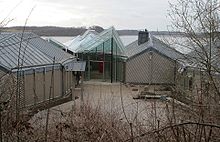
Hedeby was an important Danish Viking Age trading settlement near the southern end of the Jutland Peninsula, now in the Schleswig-Flensburg district of Schleswig-Holstein, Germany. Around 965, chronicler Abraham ben Jacob visited Hedeby and described it as, "a very large city at the very end of the world's ocean."
Truso was a Viking Age port of trade (emporium) set up by the Scandinavians at the banks of the Nogat delta branch of the Vistula River, close to a bay, where it emptied into the shallow and brackish Vistula Lagoon. This sizeable lagoon is separated from the Gdańsk Bay by the Vistula Spit at the southern Baltic Sea coast. In the 9th century, the merchant Wulfstan of Hedeby travelled to Truso in the service of the English King Alfred the Great and wrote his account of the place at a prominent location of the Amber Road, which attracted merchants from central and southern Europe, who supplied the markets in the Mediterranean and the Middle East with the highly valued commodity.
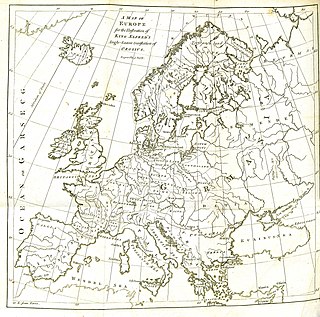
Wulfstan of Hedeby was a late ninth-century traveller and trader. His travel accounts, as well as those of another trader, Ohthere of Hålogaland, were included in the Old English Orosius. It is unclear if Wulfstan was English or indeed if he was from Hedeby, in what is now northern Germany near the city of Schleswig but in the 9th century was Danish.

Schleswig-Flensburg is a district in Schleswig-Holstein, Germany. It is bounded by the districts of Rendsburg-Eckernförde, Dithmarschen and Nordfriesland, the Region Syddanmark in Denmark, the city of Flensburg and the Baltic Sea.

The Schlei is a narrow inlet of the Baltic Sea in Schleswig-Holstein in northern Germany. It stretches for approximately 20 miles from the Baltic near Kappeln and Arnis to the city of Schleswig. Along the Schlei are many small bays and swamps. It separates the Angeln peninsula to the north from the Schwansen peninsula to the south.
Ring was a Swedish monarch or local ruler who ruled at Uppsala, an important early Swedish political center, around or before the year 936. He either ruled before or together with his two sons Eric and Emund. Virtually nothing is known about him beyond his name.
Olof was, according to Adam of Bremen, a Swedish chieftain who conquered Denmark c. 900 and founded the House of Olaf. Evidence for his historicity is only circumstantial, since he belongs to a period of Danish history when very little is known from textual sources.

Reric or Rerik was one of the Viking Age multi-ethnic Slavic-Scandinavian emporia on the southern coast of the Baltic Sea, located near Wismar in the present-day German state of Mecklenburg-Vorpommern Reric was established probably in 735 shortly after Slavs of the Obodrite tribe had started to settle the region. At the turn of the 9th century, the citizens of Reric allied with Charlemagne, who used the port as part of a strategic trade route that would avoid areas of Saxon and Danish control. It was destroyed in 808 AD by the Viking (Danish) king Gudfred. The destroyed place was rebuilt by the Obodrites and continued to operate for a short until Drasco was murdered in Reric in 810 at the instigation of Gudfred. After that, the tradespeople were reportedly moved by the king to the Viking emporium of Hedeby near modern Schleswig.

The Thorsberg chape is an archeological find from the Thorsberg moor, Germany, that appears to have been deposited as a votive offering. It bears an Elder Futhark runic inscription, one of the earliest known, dating to roughly 200 CE.

The Hedeby stones are four runestones from the 10th century found at the town of Hedeby in Northern Germany. This area was part of Denmark during the Viking Age.
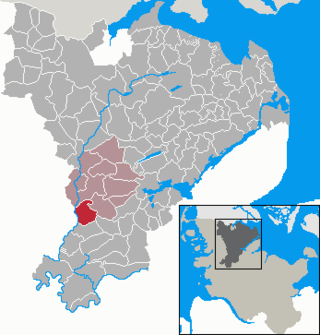
Hollingstedt is a municipality in the district of Schleswig-Flensburg, in Schleswig-Holstein, Germany, located on the Treene river.

Sebbe Als is a replica of a Viking ship, Skuldelev wreck no. 5. She is the oldest sailing 'fiver' in Denmark.

Östergötland Runic Inscription MÖLM1960;230 or Ög MÖLM1960;230 is the Rundata catalog number for a memorial runestone that is located near a church in Törnevalla, which is 2 kilometers east of Linghem, Östergötland County, Sweden, which was in the historic province of Östergötland. The runestone has an inscription which refers to a Viking Age mercantile guild and depicts a ship.

Herbert Jankuhn was a German archaeologist who specialized in the archaeology of Germanic peoples. He is best known for his excavations at the Viking Age site of Hedeby, and for his instrumental role in the publishing of the second edition of the Reallexikon der Germanischen Altertumskunde.

The Kyrkogården Runestones are three Viking Age memorial runestones located at the cemetery of St. Mary's Church in Sigtuna, Stockholm County, Sweden, in the historic province of Uppland. One of the runic inscriptions documents the existence of a Viking Age mercantile guild in Sweden.

Pingsdorf ware is a high fired earthenware, or proto-stoneware, that was produced between the late 9th and 13th century in different pottery centres on the Eastern margin of the Rhineland as well as the Lower Rhine region. Characteristic features of vessels in Pingsdorf ware are a yellow-coloured fine sand-tempered sherd and a red painting. It is archaeologically evident within various Medieval settlements of North Western Europe and thus represents an important chronological marker for the Medieval archaeology.

While the Vikings are perhaps best known for accumulating wealth by plunder, tribute, and conquest, they were also skilled and successful traders. The Vikings developed several trading centres both in Scandinavia and abroad as well as a series of long-distance trading routes during the Viking Age. Viking trading centres and trade routes would bring tremendous wealth and plenty of exotic goods such as Arab coins, Chinese Silks, and Indian Gems. Vikings also established a "bullion economy" in which weighed silver, and to a lesser extent gold, was used as a means of exchange. Evidence for the centrality of trade and economy can be found in the criminal archaeological record through evidence of theft, counterfeit coins, and smuggling. The Viking economy and trade network also effectively helped rebuild the European economy after the fall of the Roman Empire
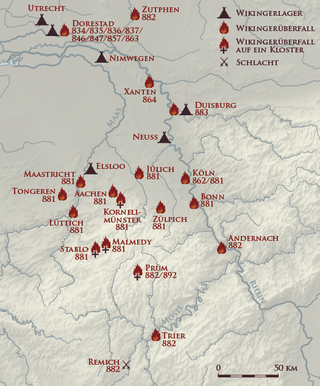
The Viking raids in the Rhineland were part of a series of invasions of Francia by the Vikings that took place during the final decades of the 9th century. From the Rhineland, which can be regarded as the nucleus of Frankish culture, the Franks had previously conquered almost the whole of Central Europe and established a great empire.

Sunhild Kleingärtner is a German historian and archaeologist, specialising in maritime history and maritime archaeology.
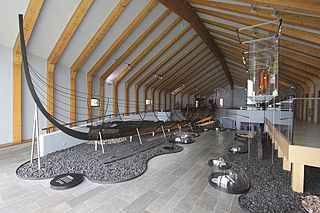
The Hedeby 1, also known as the Ship from Haithabu Harbour, was a Viking longship that was excavated from the harbor of Hedeby, a Viking trading center located near the southern end of the Jutland Peninsula, now in the Schleswig-Flensburg district of Schleswig-Holstein, Germany.
